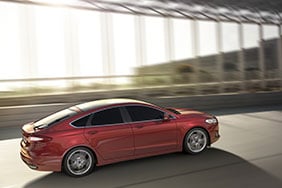The future of car ownership has been a hot topic in the insurance industry for decades, with many people predicting the decline of cars for years.
Car insurance and ownership costs have been increasing over the years – and yet car ownership is still climbing. In 2021, 33% of households had more than 2 cars, compared to 8% in 1971.
So what’s happening? Are people turning to car clubs and subscription services? What do I think is going to happen in the next few years?
In this article, I'll be going through:
- What factors are contributing to the changing landscape of car ownership?
- What are the alternatives to car ownership?
- What are the trends in the coming years?
- What role will price comparison websites (PCWs) and Confused.com play?

What factors have contributed to the changing landscape of car ownership?
Car ownership trends all come down to people’s everyday habits. People don’t typically change their driving habits without a specific reason. More often, it’s a shift in lifestyle that leads to a change in habits.
The Covid-19 pandemic accelerated many of the trends that were already happening. In general:
- We're using our cars less
- We're using them for shorter trips
- We're using public transport more
Figure from Gov.uk.
However, the reason for making a trip by car hasn't changed a lot over the years:
Figure from Gov.uk.
The underlying reasons for driving aren’t changing much. However, things could change in 2023. The cost of producing car parts, labour and overall inflation is leading to an increase in the cost of car ownership.
Will we reach a tipping point in 2023? Will car ownership costs increase so much that people will start selling their cars?
That’s entirely possible. It all comes down to what people use their car for.
Here are some trends that are impacting car ownership:
Increase in younger people living in urban areas
According to the UN, 55% of the world population lived in urban areas in 2018. They predict that by 2050, that number will be 68%.
More people are moving to cities, and urban living makes car ownership impractical. The lack of space, congestion charges and increased emissions means that owning a car often doesn’t make sense.
Urban residents want flexibility and convenience, and it often doesn’t make sense to own a car when you can use on-demand mobility services like Uber or public transportation.
Ownership in London is already much lower than other parts of the UK, so it’s not a stretch to believe this is a trend that will keep going.
Covid-19 has changed how people live and work
As I said earlier, car ownership trends are dependent on lifestyle trends. With Covid-19, we saw a shift in circumstances that did have an impact on travel habits.
The biggest one was commuting to the office. In 2023, 1 in 4 UK workers work a hybrid work week, with 16% being full-time remote work. The result is that many workers are going into the offices a few times per week or month. Already, 51% of all rail trips are for commuting or business purposes. Public transport is what currently dominates commuting travel.
With advances in ecommerce platforms and the rise of delivery services, we’re also seeing shopping undergo a transformation. Fewer people use their car for the weekly shop if they feel comfortable doing it all online (according to GOV.UK, we already saw a drop of 6% in car shopping trips in 2021).
More consumers want a variety of choices when driving a car
Many people are no longer concerned with owning products outright. People increasingly engage with media using subscription-based streaming services like Netflix and Spotify. The reality is that people no longer own movies or music, and instead prefer the subscription model.
Consumers are used to this type of on-demand service, which is why many are now expecting the same dynamic in other industries. They want the freedom to pay via subscription, to be able to cancel at any time and easily add and remove people or features from their subscription.
Why not do the same with cars? More customers are choosing to use a car club, subscribe to a car service or use ride-sharing services like Uber. It doesn’t necessarily mean they no longer own a car: they might still own a car but also use car subscription services for other situations (for example, when driving abroad or when doing short distances).
Let’s look at the alternatives to car ownership and what we could see becoming more popular in the near future.
What are the alternatives to car ownership?
Car subscription services
With a car subscription service, customers can choose to pay for access to a car on a monthly basis. Manufacturers like Volvo or companies like Drover allow customers to pay a monthly fee for access to a car. Included in the fee is roadside assistance, maintenance services, insurance and all the necessities for owning a car.
We’ve seen this model disrupt other sectors as well, such as HelloFresh with the food sector. Gen Z has had music and other entertainment subscriptions their whole life – having a subscription for a new car isn’t too far of a stretch.
Also, for the younger generations, cars could be seen as less of a status symbol. Instead, their priority is convenience. With a car subscription, you can cancel anytime and sometimes upgrade and choose to add more to your subscription.
However, there are limitations to this type of product: the only group of customers who’d be interested are younger generations, and for them it’s still expensive. There are also strict conditions of usage such as not being able to leave the UK.
Ride-sharing companies
The other alternative is ride-hailing services like Uber that have quickly gained huge market traction. They’re a classic example of a service that’s convenient and that works well for urban living.
The rise of the gig economy and availability of drivers has also helped keep prices low, especially compared to taxis.
Car sharing and car clubs
With car sharing, consumers can either pay to rent someone else’s car, or join a car club that gives them access to a car on demand.
This type of car driving has been around for 10 years, with car sharing platforms like Zipcar and Turo offering drivers the opportunity to pick up a car when convenient. You reserve the car and then pay by the hour, and insurance is baked into the fee.
It’s a good way to serve customers that only drive 3,000 - 4,000 miles per year. According to ING, by 2035, one in every nine cars sold per year will be a ‘shared car’.
Two key challenges with car clubs are infrastructure and trust. Local authorities still need to invest a lot into building additional parking spaces. And on top of that, people usually don’t trust strangers to drive their car.
What will be bigger in the next 3 - 5 years?
Of these car alternatives, what will we start using more of in the next few years?
It depends on whether we’ll see more lifestyle changes. If more people decide to do their grocery shop online, then fewer people will use cars for shopping. If the cost of living crisis means car ownership starts to decrease, then we’ll see many more people using car clubs and public transport.
Here’s what I think will be bigger in the next few years.
Using one app for all your transport needs
A concept that is gaining momentum is ‘Mobility as a Service’ (MaaS), which means using one app to plan and track all your travels.
Most cars are idle for 96% of the time, so how can we use them more as a resource? Apps like Whim and NaviGoGo have been trialled across Europe to help increase efficiency of cars. For example, Whim gives users the opportunity to book and use all forms of transport in their area. Whim bundles taxi services, bus and train services together, and you can choose to pay per journey or pay for a monthly flat fee for unlimited journeys.
MaaS apps help with flexibility: it allows you to make the most of your car, while still making use of other modes of transport. Younger generations tend to love flexibility, which is why I believe we’ll only see more of it.
More people leasing cars due to electric cars’ rising popularity
Electric vehicles (EVs) are growing in popularity primarily due to environmental concerns as well as regulations such as low emission zones.
In 2022, the share of electric cars as total sales was 14%, 3 times what it was in 2020 (4%). In the first quarter of 2023, over 2.3 million electric cars were sold, 25% more than were sold during the same period last year. In June 2023, the Tesla model Y was the best-selling vehicle.
With government subsidies and the expected ban on the sale of petrol and diesel cars by 2040, I’m confident we’ll see more electric cars in the years to come. However, this will only be possible if infrastructure keeps up with demand.
Peer-to-peer car sharing
Of all the car ownership model alternatives I mentioned above, I believe that car sharing and car clubs will become even more popular over the next few years.
The main challenge with car sharing is building trust between strangers. However, it’s entirely possible that this’ll eventually adapt and we’ll eventually become comfortable renting out our cars just like we do with our homes.
Although more people still own private cars, it’s possible we’ll reach a tipping point where the cost of owning a vehicle outweighs the benefits, and more people will switch to car sharing and car club companies.
What hasn’t taken off?
To get a better insight into what will be more popular in the years to come, it’s also worth looking at what hasn’t taken off.
Telematics
Around 10 years ago, Confused.com was one of the first companies to launch a telematics service as a smartphone app. You could download our app, and it would score your driving from your phone. We eventually discontinued it because of lack of demand.
Telematics hasn’t taken off – only 26% of drivers have black box insurance.
Why? It’s all about reciprocity. If, as a customer, you’re giving all of your driving data, then you expect cheaper insurance costs. But if the savings aren’t enough for you to give your data, then usually you won’t give it in.
The solution to more personalised insurance is a larger focus on flexibility. For example, insurers could offer shorter and more flexible policies if the car is mostly sat on the customer’s driveway.
Autonomous vehicles
Although there have been talks about autonomous vehicles for years, they still haven’t gained traction.
There are too many question marks that need answering before autonomous vehicles become the norm.
With aeroplanes, we’ve automated 90% of the process but there’s always a pilot for landing and take off. With self-driving cars, it’ll be the same - we can automate them when they’re on the motorway, but we’ll always need a driver for urban areas.
How is Confused.com staying on top of car ownership trends?
We offer temporary car insurance and allow customers to compare different types of car insurance
As I’ve mentioned before, one of the key trends we’ve seen is more customers wanting flexible car insurance.
Confused.com offers to compare temporary car insurance policies: cover that they can use for 1 hour up to 28 days. This type of cover is cheaper (if not driving regularly), is fully comprehensive and not tied to a long contract.
Customers can also choose to compare different types of insurance on our platform, such as pay per mile, telematics and black box insurance.
We have a car insurance app with a running costs calculator
In 2023, it’s likely we’ll see car costs increasing due to the cost of living crisis and price inflation. We’re already seeing a 40% year on year increase in the cost of car insurance. Our Confused.com app allows our customers to track the costs involved with car ownership and make it easier for them to get an insurance quote.
Our app includes:
- Vehicle research tool: Full vehicle history including MOTs.
- Running cost calculator: Compare the running costs of different vehicles.
- The ability to get a quick quote for a car insurance policy.
- The opportunity to claim rewards, such as money off fuel and car washes.
We continue to play the role of the customer champion
No matter how a customer prefers to own their car, we still play the role of the consumer champion.
One example of this was a case in 2022 of a customer not receiving a fair payout for their vehicle. We took up the fight on their behalf and explained to the insurer that the offered price didn’t align with the market value of that vehicle. Finally, the insurer did agree to pay out at market rate.
We’ve always ensured that car owners get value from their insurer, and we’ll continue to adapt as the relationship evolves. We remain focused on educating customers on their rights and protecting them from unfair practices. That’s no matter how they drive – whether they use more MaaS apps, rent out their cars or buy an electric vehicle.
What is the future of car ownership? The answer depends on how lifestyles will adapt and whether trip purposes will change. I believe we’ll see more MaaS apps, car sharing and car clubs and more focus on electric vehicles. With the cost of living crisis and inflation, I do believe we’ll see a tipping point where fewer people will buy cars and the sharing economy will become more dominant.
Learn more about our story at Confused.com.









